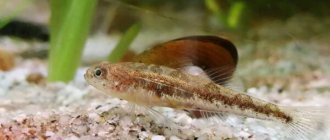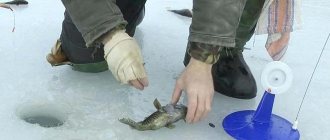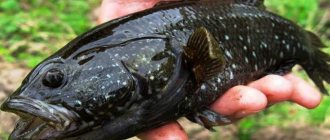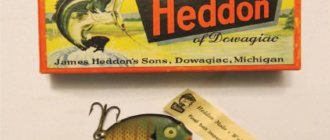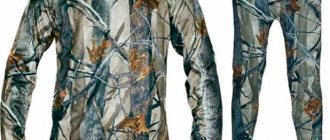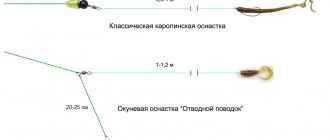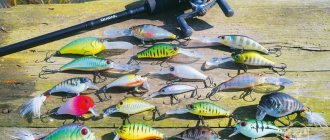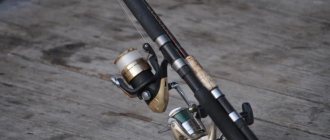Rotan fish - description, general characteristics
Rotan is a fairly common fish in Russia and is well known to fishermen.
Body structure
Rotan has a dense body, rounded in the front and slightly tapering towards the tail, covered with medium-sized scales. The head is large, flattened on top, making up about a third of the entire fish.
Rotan has fins: 2 well-developed dorsal, large pectoral, short anal, rounded caudal, and 2 small underdeveloped ventral fins. The largest is the second dorsal; in some individuals it can exceed the height of the body.
The fins are soft and have no spines. The color is different, the main colors are gray-green and brown-brown with small uneven spots and dots, the abdomen is gray. Females are less intensely colored and paler than males. During the spawning period, rotan males darken, becoming almost black.
REFERENCE: Also, the color depends on the type of reservoir where the rotan lives. In cleaner waters, the scales of these fish are lighter than those of individuals living in wetlands.
Fish length
Depends on the habitat, can reach from 10 to 35 cm, on average is from 12 to 14 cm.
Firebrand mouth and teeth
The mouth is large and wide, the lower jaw is strongly pushed forward. In the rotan's mouth there are several rows of small sharp teeth that can be renewed.
Is this a predatory fish?
Rotan is a predator, voracious and almost omnivorous.
What is the difference between rotan and goby
Rotan and goby are similar in appearance, as a result of which confusion sometimes arises, so it is mistakenly classified as a representative of goby fish. However, they can be distinguished by a characteristic feature - the structure of the ventral fins.
In rotan they are paired, located close to the head, small and narrow, while in the goby the fins have fused into one large one, shaped like a suction cup.
The goby also does not have such a large head, and it has longer second dorsal and anal fins.
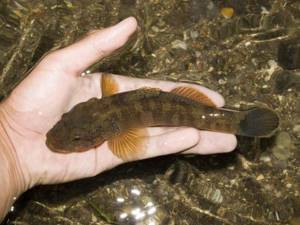
What does a goby look like and where is it found?
Gobies are found in almost every Eurasian reservoir; they are unpretentious and hardy, capable of adapting to even the most dangerous conditions. Due to the rapid reproduction and high survival rate of juveniles, the population of the species grows very quickly, which makes the fish very valuable for the food industry.
Anyone who knows a little about fish can recognize a goby by its appearance. She has a large round head, bulging eyes and wide lips. The body of the fish is short, it can reach a maximum of 25-27 cm, there are species that grow up to 40 cm, but they are extremely rare. These inhabitants of reservoirs have a wide back and large fins. The skin color can be anything from light gray to black with light yellow spots, depending on the species. Gobies eat fry, mussels and other aquatic life, and plankton with pleasure.
Habitat
The original habitat is the Amur Basin and northeast China. At the beginning of the 20th century, the fish was discovered in Lake Baikal (it is assumed that the eggs were brought into the lake with birds). Later, rotan began to be imported from the east to the central and northern regions of Russia, where it became popular among ordinary people due to its unpretentiousness to living conditions.
People began to release it into various reservoirs, where rotan adapted perfectly, thus conquering more and more new habitats. Currently, it is observed in most of the territory of Russia and many European countries, in the basin of the Volga, Dnieper, Danube, Don, Irtysh, Ob, etc.
Rotan prefers to live in small, weakly flowing or stagnant bodies of water, for example, in overgrown floodplains or wetlands. It is very tenacious and unpretentious; it can live in muddy ponds, swamps, and even ditches.
It is insensitive to a lack of oxygen and the chemical composition of water, usually prefers places where there are few other fish, and its natural enemies - salmon, pike, eel, perch, pike perch - are absent.
REFERENCE: Capable of existing in a wide range of temperatures, and can even temporarily survive increases above 30 °C. The ability to survive freezing into ice is also known. The firebrands overwinter in ice cavities or burrow into silt.
How long has it been since you had a really BIG CATCH?
When was the last time you caught dozens of HUGE pike/carp/bream?
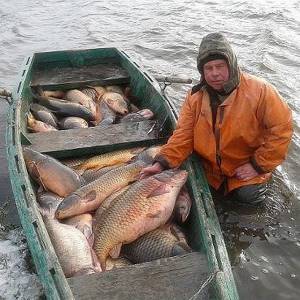
We always want to get results from fishing - to catch not three perch, but ten kilogram pikes - what a catch! Each of us dreams of this, but not everyone can do it.
A good catch can be achieved (and we know this) thanks to good bait.
It can be prepared at home or bought in fishing stores. But stores are expensive, and to prepare bait at home, you need to spend a lot of time, and, to be fair, homemade bait does not always work well.
You know that disappointment when you buy bait or prepare it at home and only catch three or four bass?
So maybe it’s time to use a truly working product, the effectiveness of which has been proven both scientifically and in practice on the rivers and ponds of Russia?
It gives the same result that we cannot achieve on our own, especially since it is cheap, which distinguishes it from other means and there is no need to spend time on production - you order it, it’s delivered and you’re good to go!

Of course, it is better to try once than to hear a thousand times. Moreover, now is the season! This is a great bonus when ordering!
Find out more about the bait!
Rotan is a fish of the order Perciformes. Its body does not exceed 25 cm in length. Amur sleeper is found in the rivers of Primorye and in the Amur basin, but several decades ago it was introduced into many reservoirs, where in a short time it became the main inhabitant.
Rotan is a small fish, often called firebrand. Its color is dark, from brown to almost black. Brown spots are clearly visible on the belly and sides. The rotan is also distinguished by two separate dorsal fins. The closest relative of this species is the southern goby. The rotan's mouth is large, it is directed upward, protruding forward barely noticeably. Pelvic fins are separate. During spawning, males become almost black. Probably, it is for this reason and, perhaps, for its low mobility that rotan is called a firebrand.
This fish prefers to stay near flooded bushes, in small snags, and in shallows. It feeds mainly on animal food. Rotan is a fish that most prefers the eggs of fry, so it very quickly minimizes the number of other species in the reservoir. Very often, where this species settles, after a year or two there are no other fish left. Amur sleepers reproduce only in summer; females lay their eggs on the lower part of the leaves of aquatic plants. Most often, spawning occurs in thickets of pondweeds, egg capsules and water lilies. The number of eggs in one such clutch is about 10 thousand. Rotan is a very tenacious fish. It can survive even where other species, including crucian carp and tench, die.
Today, rotan is an inhabitant of almost all reservoirs of Russia with the exception of the Crimean Peninsula. But it is possible that it will soon appear in these places. It has been noticed that in those reservoirs where perch and pike are active, rotan fails to take a leading position. These species do not allow it to reproduce heavily and eat the eggs of peaceful fish. But in ponds and lakes where only crucian carp lives, rotan very quickly masters and becomes the master of the situation. Most often, this voracious fish turns out to be the only inhabitant of small reservoirs with very harsh living conditions. These are stagnant quarries, overgrown with mud, overgrown ponds. Rotan is able, no worse than crucian carp, to withstand a critical lack of oxygen and complete freezing of a reservoir in winter.
Rotan is a fish that can be a lot of fun to catch. The largest individuals stay under the cover of duckweed or under the wide leaves of water lilies. This behavior is completely unusual for bulls. When the reservoir is heavily overgrown, they look for clearings or windows among aquatic vegetation. Such places can be created artificially, even with the help of an ordinary shelf. Rotans are not at all shy. They float to a place free of vegetation very quickly, and are not bothered by the presence of humans. Another interesting feature was noticed. Rotan loves the red and white float very much. The reasons for this are not clear. But the fishermen noticed that it was he who attracted the attention of the nimble fish.
This is such an interesting rotan fish. A photo of her can be seen in this article. This fish has individuality and is undeservedly not popular among professional fishermen.
Rotan
-
fish
brought from the East. In Russian reservoirs, the voracious predator, indiscriminate in food and not picky about living conditions, has found only a few competitors. Therefore, the dominance of local water bodies by rotans began.
Such expansion is not only bad for the ecosystem, but also does not suit the fishermen. In terms of taste, rotan
trash, has no value. You want to tinker with your catch even less when you feel thick and foul-smelling mucus on your hands. It generously covers the entire body of the fish.
Development and reproduction
It is capable of intensively reproducing and rapidly increasing its population, which, combined with endurance and vitality, further contributes to its spread.
When does puberty occur?
Rotans reach maturity by 2 years. The spawning period occurs in May-July at a water temperature of 17−22°C. The female's fertility is about 1000 eggs, which she lays on plants and various objects (stones, driftwood), fixing the eggs on them with the mucus she secretes.
The clutches are guarded by males, fanning them with their fins to provide greater access to oxygen.
How big does rotan grow?
Rotan can reach a length of 25−35 cm, but such large individuals are rare. The average size is 12−14 cm.
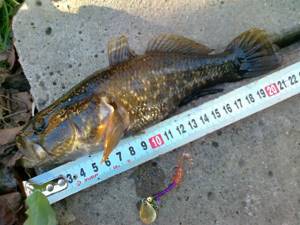
The largest rotan
The weight of rotans very rarely exceeds 500 g. On average, their weight is about 200 g.
How long does he live?
Average life expectancy is 7-10 years. It can live up to a maximum of 15 years.
Features of behavior
Rotan is considered a so-called weed fish, because in small bodies of water, in the absence of natural enemies (pike, perch, eel), it eats and displaces smaller fish and is capable of destroying their entire population. Unpretentious and indiscriminate in food.
When the fish is completely full, it becomes almost 3 times larger. Once saturated, rotan lies on the bottom, where it can digest food for up to three days.
It hunts by lying in wait for prey in underwater thickets. He has good eyesight, which allows him to see from afar. Prefers standing or flowing waters, does not live in places with fast and moderate currents.
REFERENCE. Rotan can survive for a long time with a lack of oxygen, so it is easy to move it from pond to pond in a jar or bucket.
Lifestyle
In addition to the fact that rotan is an active and quite dangerous predatory fish, it is characterized by cannibalism. The diet of firebrands consists not only of fry and eggs of other representatives of the ichthyofauna, but also of their own relatives. Adult fish eat almost everything that moves - even leeches and tadpoles. The fry menu includes plankton and zoobenthos.
Look at the silver bream - habitats, lifestyle and characteristics of the species. Fish habits and methods of catching silver bream (115 photos)
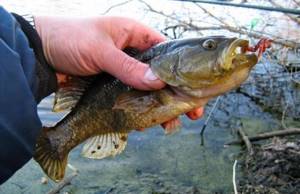
Despite the small size of rotan fish, its appetite is terrifying. She does not know a sense of proportion, so she can cause the disappearance of other species of fish in a single pond. It is not for nothing that the firebrand is considered a trash fish, and the reservoirs in which it swims are considered biologically polluted.
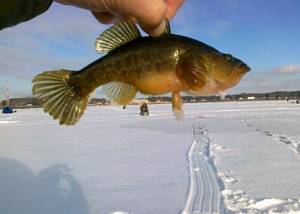
Rotan is also food for larger predatory fish, such as pike and perch. Fishing for it is quite an interesting event, especially if it happens in winter.
Fishing for rotan
Of interest only to amateur fishermen. Rotan is easy to catch, it bites on almost everything - earthworms, maggots, raw meat or lard, as well as various jigs and spoons; sometimes it is enough to attach red threads to the hook.
Read: Guide to choosing a jig for rotan during winter fishing
No special fishing equipment is required, you only need a fishing line with a hook.
It is absolutely not shy and is omnivorous, so in a short period of time you can catch a large number of rotans. You can catch it at any depth. It is best to catch firebrands in the spring or summer, since in the fall they begin to hide, and in the winter they go to the bottom and hibernate.
IMPORTANT. Can be used as live bait for catching predatory fish. Thanks to its vitality, one individual is capable of serving all day.
Read: Peculiarities of catching rotan in different weather conditions
Types of gobies
From Odessa to the Eastern coast of Crimea you can successfully catch a goby, the size of which varies from 10 to 30 cm. This is a whip goby. It is found at the mouths of rivers such as the Dniester and. More than a quarter of this bull's body is on the head.
In the old days, the catch of goby in the Black Sea accounted for up to a third of the total fishery volume, but now this fish is becoming less and less every year. The reason is banal - ill-considered economic (or rather, mismanagement) human activity.
Continuous improvement of the coast led to the removal from the beaches of stones on which gobies laid eggs. Other names for this fish are martin goby and toad goby. This is the most valuable type of goby for fishermen.
In rivers such as the Dnieper, Danube, Dniester, and Southern Bug there is a messenger goby fish. It is much smaller than the Black Sea goby. The maximum dimensions reach 15 cm. It is precisely because of its size that the messenger goby is rarely eaten, although its meat is quite tasty.
The rotan goby is also called a firebrand because of its disproportionately large head. The ability to quickly adapt to new conditions makes it possible to assume that rotan will soon occupy almost all bodies of water. It is aggressive and voracious; the survival rate of rotan is very high. The sizes of individual individuals reach 30 centimeters or more, they are fascinating and productive, you just need to know where they live, and choosing bait is not difficult at all.
A small gray-green goby that lives in the waters of the Azov-Black Sea basin, in particular in. Often this small fish ruins all attempts to catch something more worthy.
Typically, a concentration of bull goby is observed where there is a sandy bottom. In general, all gobies are bottom fish. They, like most other inhabitants of water bodies, are sensitive to changes in weather conditions, so, despite their gluttony, it is not possible to say that the goby is an easy prey for a fisherman.
It can be said without exaggeration that this is a legendary fish. In the city of Berdyansk, Zaporozhye region, they even erected a monument to the Azov breadwinner bull!
We, in Mariupol, do not have a monument yet, but every city resident has great respect for this fish. Some people “respect” to catch it, others to eat it, but the majority combine these pleasures. Goby fishing has simply become widespread.
You can catch it along the entire sea coast. The word “goby” refers to several species at once.
Gobies of the Sea of Azov
Geisha (geishak). I don't know if this name has anything to do with Japanese courtesans. It is also called disheveled. Not exactly a desirable catch. Half-body head and thin tail. There is nothing to eat there, especially in dried form. He is also unattractive in appearance, something gray and inexpressive. Up to 20 cm;
Martovik, aka “Berdyansk”, although in Berdyansk no one calls him that. The largest species, according to experienced fishermen, reaching a weight of 1.5 kg. I haven’t caught or even seen such martins, but I once caught one that was 760 grams and half a meter long! They start catching “Berdyansk” back in January from ice, and it is valued not so much for the taste of its meat, but for its large caviar, which can be quite a lot in one belly. It is the very first to approach the shores, or more precisely, to the stone placers, and all lovers of goby fishing are waiting for this moment. They catch it with twitching rods, that is, in a plumb line, since the use of any hook on the stones guarantees a snag and breakage of the tackle. Appearance bright: large head with a protruding jaw, orange-red with brown spots;
Round timber. The fattest, well-fed and therefore especially valued by fishermen. Something like a sausage with teeth and a tail. A small round head with a huge mouth. The color can be very diverse, which, by the way, changes quickly. It depends on the habitat. Up to 25 cm;
Fireman. This is probably a subspecies of the round goby, but locals consider this goby to be a separate species. Completely black, pitch-colored. The dorsal and pectoral fins are wide, with a beautiful fluorescent turquoise edge. In Berdyansk, the monument is most likely to him, judging by its appearance. Up to 25 cm;
Sandstone. A gray-yellow goby that lives on sandy rifts, with a small, slightly elongated head and a small mouth. Up to 20 cm;
- “toad”. This is some kind of b-e-e... A huge, completely flat, pimply head and a rope-tail coming straight out of it. The central, dorsal-abdominal part is so small that it is not noticeable. The good news is that it is extremely rare in catches. Up to 12-15 cm.
Sandy and rocky shallows are considered the most catchy places. There is also a goby on the muddy bottom, but on the hard bottom there is incomparably more of it. In Mariupol, rocks on the Left Bank (stadium area), Sandy Beach, and Komsomolsky Beach are considered “bull” places. The water stations belonging to the Azovstal and Azovmash plants, located on Primorsky Boulevard, are very convenient for fishing. In the same area there are breakwaters that extend far out into the sea, from which bullheads are also caught.
On its left edge, the Sandy Beach abuts the port facilities, along which a two-hundred-meter reinforcing stone rampart is built. This is where the fishing for the “Berdyansk” goby begins in March. Having spawned, the martin fish moves out to sea, to the shipping channel, to the depths, and round timber comes en masse in its place. At this time, there is absolutely no free space on the stones; behind each person fishing there is a line of people wanting to take his place. Friends and acquaintances give each other a place, having agreed in advance by phone.
Goby tackle
Any tackle is suitable for a goby, the only requirement is the presence of three elements: fishing line, sinker and hook. You can literally fish from your finger by tying a fishing line to it, but usually they use a rod with guides and a small reel. The rod length varies from 1.5 to 7 meters, fishing line from 0.25 mm to 0.7 mm, hook No. 6-10 according to the old Soviet classification and with a long shank.
Only for catching sandstone, you need to take a slightly smaller hook, size No. 5-7 and with a fore-end of medium length, about 20-25 mm, since a large hook, and even with bait, simply does not fit in its mouth. The sandstone feeds on small bottom organisms, shells and the “sea flea” - mormysh, which has successfully adapted to the low salinity of the Sea of Azov. In a good bite, you can catch as much as you can from one point, although no one has canceled the catch norm - up to three kilograms per person per day.
Bait for catching a goby can be almost any (if necessary) product of animal origin, but usually these are pieces of beef, spleen, crawling worm, squid, grape snail, liver. Martovik likes sprat. The goby is caught on shrimp and even “on its own,” that is, on pieces of cut goby. In my practice, I also fished with sausage (when I ran out of bait) and even with a cigarette filter!
A week or two after the first wave of round timber appears on the rocks, with the water warming, the main part of it occupies the entire coastal strip. Already a meter from the surf you can catch fish, but mostly small ones. Hungry for prey and simply wanting to spend time with a fishing rod in hand, take positions on Sandy Beach. Here and now we need more powerful and long-range gear, since the number and size of trophies will depend on this. “Particularly hungry” anglers can have up to a dozen hooks on one rig! In relation to catching a goby on a "gerbil" there is a sign - whoever sleeps for a long time walks a lot... This means that you need to take a seat here very early, otherwise you will have to walk for a long time on the sand, looking for a “window”, or go to the very edge of the beach.
And the “very edge” is not very close, on some days the line of fishermen stretches for kilometers towards the Komsomolsky beach, which is there, on the right, under the clay mountains...
It is unknown who called the beach “Komsomol” and under what circumstances, but there is a version that it got its name because of its remoteness. Transport never went there, the population in those days had practically no cars, and young people of Komsomol age reached solitude with brisk steps in about 40-50 minutes. At the far edge of the “Komsomol” beach, a nudist beach was spontaneously formed, which was often “herded” by the police. First they took photographs (for evidence or for personal collections - unknown), then they detained, etc.
In early spring and autumn, this narrow, in some places only two meters wide, strip of sand is free from vacationers. Once upon a time, places under a clay cliff were very popular among fans of goby fishing - there are scatterings of shell rock not far from the shore, it is easy to throw in gear. True, there is a certain risk of getting wet and even drowning if you miss the beginning of a storm or even just excitement. It can just be washed off! And sometimes there were collapses... I saw one like this once, when a “piece” the size of a five-story building collapsed, or rather, quietly (completely!) slid into the water two hundred meters to the left of me, blocking the road to the house. Tough! How can I imagine what would have happened... no one would have found it, never.... Since then, no way in that direction!
To catch gobies from the shore, I use a pair of simple carp fish 3.6 meters long. On a “gerbil” you need to throw far, and underwater currents constantly change direction - so you need a good load, which you can only throw with a carp fish. It is better not to use good, expensive gear (if you have it) for such fishing; sand and salt, however, are not their best friends...
Actually, it’s a stretch to call this activity fishing; it’s more like work. I baited the tackle and threw it, baited a second one and threw it away. The first one already has a garland of bulls, take it out, take it off, load it, throw it away. And all over again. It’s boring, but it’ll do to “get your teeth on edge.” Yes, and dried bull is good, especially in the fall, when it puts on fat. But it will be already in the fall, until which you still have to live, but the goby is being caught now, the city is buzzing “the Azov goby is coming!”, and you inevitably obey the general mood...
Biological and economic significance
It has no commercial value.
It is capable of actively displacing other fish species from water bodies, so the number of rotans themselves always remains at a high level. If there are no natural predatory enemies in the reservoir, it completely destroys roach, dace and even crucian carp, so firebrands should be dealt with by reducing their numbers.
There is an opinion that by eating juveniles and adults and thinning out the population of other fish, rotan allows the surviving individuals to reach large sizes and thereby ensures their greater commercial value (for example, in the case of the destruction of juvenile crucian carp or carp).
Some experts believe that in this way the firebrands stimulate the growth of other species.
Similarities and differences in the body of fish
Well, let's start with the body.
Rotan is also called a firebrand, I don’t know for sure, but there is a version that this is because of the large head, which occupies almost a third of its body. The body itself is slab-like, but slightly flattened on the sides, especially in the tail.
"data-original="/editable/users/6r/ck/2365_9kvfg0kcww.jpg" data-srcset="/editable/users/6r/ck/2365_9kvfg0kcww.jpg, /editable/users/6r/ck/ 2x" width= “800″ height=”597″ alt=”Rotan. Large head, body flattened laterally.” data-device=»FinePix JX550, FUJIFILM» data-datetime=»16:35, 02 Oct 2015″ /> Rotan. Large head, body flattened laterally.
The head of the round goby and sandpiper goby is more modest, not of such enormous size. The body is round, slab-shaped, flattening is observed immediately in front of the tail.
» data-original=»/editable/users/7v/7d/2365_sa0zeggsww.jpg» data-srcset=»/editable/users/7v/7d/2365_sa0zeggsww.jpg, /editable/users/7v/7d/ 2x» width= »800″ height=»450″ alt=»Round goby. The head is of normal size, the body is slab-shaped.” data-device=»FinePix JX550, FUJIFILM» data-datetime=»17:04, 22 Aug 2016″ />
Round goby. The head is of normal size, the body is slab-shaped.
